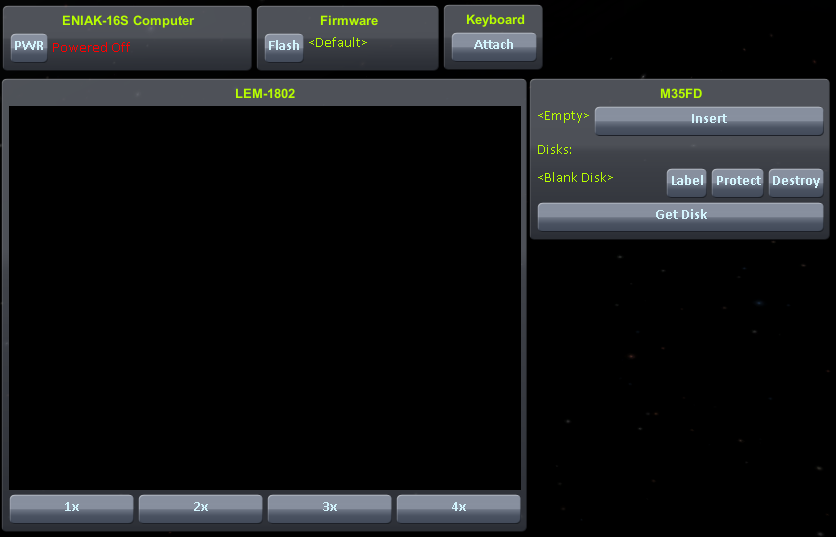-
Notifications
You must be signed in to change notification settings - Fork 1
Usage
Two new parts will appear in game under the Pods section of the craft editor: the ENIAK-16S Computer and the ENIAK-16L Computer, these "Mechanical Kerbal Brains" replace the RC-001S Remote Guidance Unit and the RC-L01 Remote Guidance Unit respectively. If you wish to use the 3D vector display, add the Suspended Particle Excited Display, Rev 3 (SPED-3) part found under the Utility section. Construct a rocket normally with one of the new parts.
When you're ready to launch, right click on the computer part to bring up its context menu. Among the usual options will be several options to toggle the interface of several devices. Toggle each of them on.

The computer window allows you to control power to the computer via the PWR button, it also displays if the computer is powered off, is halted, or is running by showing the average clock speed.
The firmware window allows you to flash the built-in firmware. The firmware contains the first code that is executed by the CPU when it powers on and is usually used to bootstrap the computer from other media.
The firmware device comes preloaded with a default firmware which will search for a floppy drive and load the first sector (512 words) from the floppy into memory and execute it. If the program on the floppy disk is longer than 512 words additional bootstrap code would be required to load additonal sectors into memory.
Alternatively, a custom firmware may be used to load additional sectors into memory. One such firmware,
firmware_ext.dasm, is provided in the Contrib/Firmware directory of the distribution. It automatically reads
the first 127 sectors (65024 words) from the floppy disk into memory. This actually, takes some time, so do not be
alarmed if your program takes some time to load. To use this firmware, first assemble it into a big-endian binary
image using a DCPU-16 assembler, such as [Organic][organic]. Then create a directory:
Kerbal Space Program/saves/<profilename>/Ketchup/Firmware under your Kerbal Space Program installation path.
Now, when you press the Flash button in the firmware window, you should be given the option to use the custom
firmware.
The keyboard window contains a single button, Attach, which when enabled sends your keyboard input to the computer.
The LEM-1802 window displays the standard monitor. The monitor's resolution of 128x96 pixels might be very small, so the buttons at the bottom allow you to change the scaling of the display.
The M35FD window allows you to interact with the M35FD floppy drive. Each vessels maintains its own copies of
floppy disks, but you may retrieve standard floppy disks via the Get Disk button. The Get Disk button will
always give you the option to retrieve a blank disk, but it will also list any floppy disk images you have in
Kerbal Space Program/saves/<profilename>/Ketchup/FloppyDisks. Image files may end in .bin or .img.
Standard object code generated by a DCPU-16 assembler may be used as a floppy disk image. See the previous discussion
under Firmware for how to load programs larger than a single sector.
Once you have retrieved a list, it will be listed under the vessel's available disks. At this point you have three options to manipulate the disk, you can use the Label button to change the label of the disk, the Protect button to enable write protection on the disk, and Destroy to destroy the disk forever. If the M35FD is empty you may press the Insert button, at which point you may select an available disk to insert into the drive. When inserted, the disk's label will be displayed and you then have the option to press the Eject button to eject it.
When a computer is powered on on a vessel, time warp is limited to 4x. Computers have a clock speed of 100KHz, relative to game time (up to 400KHz relative to real time).